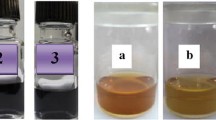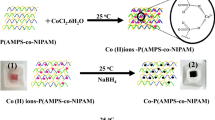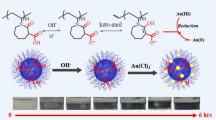Abstract
Well-dispersed gold nanoparticles (Au NPs) anchored by polymeric three-dimensional hydrogels for catalysis have received great attention, especially in aqueous-phase catalysis. In this study, thiol-functionalized chitosan poly(protic ionic liquids) hydrogel (TCPPILH) is delicately designed and prepared as a selective support material to anchor Au NPs by taking advantages of Au-thiol chemistry and facile preparation of protic ionic liquids (PILs). The TCPPILH was successfully synthesized by a protonation reaction of chitosan with 3-mercaptopropionic acid (MPA) and mercaptosuccinic acid (MSA) in water, and followed by shaping in ethanol coagulation bath via solution-gelation transition, and the properties can be facilely adjusted by changing the feed ratio of MPA and MSA. It is found that the TCPPILH can act as a selective support for adsorption of Au3+ ions, and a maximal anchoring capacity for Au NPs could reach up to 151.5 mg/g. The as-prepared TCPPILH@Au NPs catalysts were systematically characterized by FTIR, XPS, SEM, TEM, XRD and ICP-OES analysis, and the findings demonstrated that the TCPPILH could effectively inhibit the agglomeration of Au NPs (ca. 4.20 nm in diameter). As a proof of concept, hydrogenation of water pollutes, such as 4-nitrophenol and azo dyes with NaBH4 as reductant was selected as model applications, and the results indicated that TCPPILH@Au NPs catalysts exhibited high catalytic activity and satisfactory reusability.
Graphical abstract

Thiol-functionalized chitosan poly(protic ionic liquids) hydrogel (TCPPILH) was delicately designed and prepared as a selective support material to adsorb Au3+ and anchoring Au NPs by taking advantages of Au-thiol chemistry and facile preparation of protic ionic liquids (PILs). This TCPPILH@Au NPs catalysts exhibited desired catalytic activity for the hydrogenation of 4-nitrophenol and azo dyes in water.








Similar content being viewed by others
Data availability
Not applicable.
References
Alle M, Bandi R, Sharma G, Lee S-H, Kim J-C (2021) Shape recoverable, Au nanoparticles loaded nanocellulose foams as a recyclable catalyst for the dynamic and batch discoloration of dyes. Carbohydr Polym 258:117693. https://doi.org/10.1016/j.carbpol.2021.117693
Biswas TK, Sarkar SM, Yusoff MM, Rahman ML (2016) Synthesis and characterization of azobenzene-based gold nanoparticles for photo-switching properties. J Mol Liq 214:231–237. https://doi.org/10.1016/j.molliq.2015.12.078
Bratlie KM, Lee H, Komvopoulos K, Yang P, Somorjai GA (2007) Platinum nanoparticle shape effects on benzene hydrogenation selectivity. Nano Lett 7:3097–3101. https://doi.org/10.1021/nl0716000
Cao S, Mishra R, Pilla S, Tripathi S, Pandey MK, Shah G, Mishra AK, Prabaharan M, Mishra SB, Xin J, Pandey RR, Wu W, Pandey AC, Tiwari A (2010) Novel chitosan/gold-MPA nanocomposite for sequence-specific oligonucleotide detection. Carbohydr Polym 82:189–194. https://doi.org/10.1016/j.carbpol.2010.04.051
Castner DG, Hinds K, Grainger DW (1996) X-ray photoelectron spectroscopy sulfur 2p study of organic thiol and disulfide binding interactions with gold surfaces. Langmuir 12:5083–5086. https://doi.org/10.1021/la960465w
Chen Y, Li Y, Jiang L, Huang L, Lin Q, Chen G (2016) Fabrication of a heated electrode modified with a thiol-functionalized ionic liquid for electrochemical/electrochemiluminescence sensors. RSC Adv 6:39955–39961. https://doi.org/10.1039/C6RA05302E
Cheng J, Xu Q, Wang X, Li Z, Wu F, Shao J, Xie H (2019) Ultrahigh-surface-area nitrogen-doped hierarchically porous carbon materials derived from chitosan and betaine hydrochloride sustainable precursors for high-performance supercapacitors. Sustain Energy Fuels 3:1215–1224. https://doi.org/10.1039/C9SE00072K
Dambies L, Guimon C, Yiacoumi S, Guibal E (2001) Characterization of metal ion interactions with chitosan by X-ray photoelectron spectroscopy. Colloids Surf A 177:203–214. https://doi.org/10.1016/S0927-7757(00)00678-6
Dhakshinamoorthy A, Asiri AM, Garcia H (2017) Metal organic frameworks as versatile hosts of Au nanoparticles in heterogeneous catalysis. ACS Catal 7:2896–2919. https://doi.org/10.1021/acscatal.6b03386
Dong Y, Xiao C (2017) Formation and cleaning function of physically cross-linked dual strengthened water-soluble chitosan-based core-shell particles. Int J Biol Macromol 102:130–135. https://doi.org/10.1016/j.ijbiomac.2017.03.185
Fabre E, Murshed SMS (2021) A review of the thermophysical properties and potential of ionic liquids for thermal applications. J Mater Chem A 9:15861–15879. https://doi.org/10.1039/D1TA03656D
Fan J, Guo Y, Wang J, Fan M (2009) Rapid decolorization of azo dye methyl orange in aqueous solution by nanoscale zerovalent iron particles. J Hazard Mater 166:904–910. https://doi.org/10.1016/j.jhazmat.2008.11.091
Fu Y, Qin L, Huang D, Zeng G, Lai C, Li B, He J, Yi H, Zhang M, Cheng M, Wen X (2019) Chitosan functionalized activated coke for Au nanoparticles anchoring: Green synthesis and catalytic activities in hydrogenation of nitrophenols and azo dyes. Appl Catal B 255:117740. https://doi.org/10.1016/j.apcatb.2019.05.042
Ge H, Hua T, Chen X (2016) Selective adsorption of lead on grafted and crosslinked chitosan nanoparticles prepared by using Pb2+ as template. J Hazard Mater 308:225–232. https://doi.org/10.1016/j.jhazmat.2016.01.042
Ghosh P, Rameshbabu AP, Dhara S (2014) Citrate cross-linked gels with strain reversibility and viscoelastic behavior accelerate healing of osteochondral defects in a rabbit model. Langmuir 30:8442–8451. https://doi.org/10.1021/la500698v
Giri S, Das R, van der Westhuyzen C, Maity A (2017) An efficient selective reduction of nitroarenes catalyzed by reusable silver-adsorbed waste nanocomposite. Appl Catal B 209:669–678. https://doi.org/10.1016/j.apcatb.2017.03.033
Hong M, Xu X, Wang B, Guan Z, Zheng Z, Zhang Q (2022) Polymer brush-assisted preparation of magnetic Au nanocatalyst for highly efficient reduction of organic pollutants. Colloids Surf A 639:128338. https://doi.org/10.1016/j.colsurfa.2022.128338
Huang Y, Yu H, Xiao C (2007) pH-sensitive cationic guar gum/poly (acrylic acid) polyelectrolyte hydrogels: Swelling and in vitro drug release. Carbohydr Polym 69:774–783. https://doi.org/10.1016/j.carbpol.2007.02.016
Ilgin P, Ozay O, Ozay H (2019) A novel hydrogel containing thioether group as selective support material for preparation of gold nanoparticles: synthesis and catalytic applications. Appl Catal B 241:415–423. https://doi.org/10.1016/j.apcatb.2018.09.066
Jayaramudu T, Raghavendra GM, Varaprasad K, Sadiku R, Raju KM (2013) Development of novel biodegradable Au nanocomposite hydrogels based on wheat: for inactivation of bacteria. Carbohydr Polym 92:2193–2200. https://doi.org/10.1016/j.carbpol.2012.12.006
Jiang H-L, Akita T, Ishida T, Haruta M, Xu Q (2011) Synergistic catalysis of Au@Ag core-shell nanoparticles stabilized on metal-organic framework. J Am Chem Soc 133:1304–1306. https://doi.org/10.1021/ja1099006
Jiang J, Gunasekar GH, Park S, Kim S-H, Yoon S, Piao L (2018) Hierarchical Cu nanoparticle-aggregated cages with high catalytic activity for reduction of 4-nitrophenol and carbon dioxide. Mater Res Bull 100:184–190. https://doi.org/10.1016/j.materresbull.2017.12.018
Kang J, Liu H, Zheng Y-M, Qu J, Chen JP (2010) Systematic study of synergistic and antagonistic effects on adsorption of tetracycline and copper onto a chitosan. J Colloid Interface Sci 344:117–125. https://doi.org/10.1016/j.jcis.2009.11.049
Kasaai MR, Arul J, Charlet G (2000) Intrinsic viscosity-molecular weight relationship for chitosan. J Polym Sci Part b Polym Phys 38:2591–2598. https://doi.org/10.1002/1099-0488(20001001)38:19%3c2591::AID-POLB110%3e3.0.CO;2-6
Laiho T, Leiro JA, Lukkari J (2003) XPS study of irradiation damage and different metal-sulfur bonds in dodecanethiol monolayers on gold and platinum surfaces. Appl Surf Sci 212–213:525–529. https://doi.org/10.1016/S0169-4332(03)00462-8
Laomeephol C, Ferreira H, Yodmuang S, Reis RL, Damrongsakkul S, Neves NM (2020) Exploring the gelation mechanisms and cytocompatibility of gold (III)-mediated regenerated and thiolated silk fibroin hydrogels. Biomolecules 10:466. https://doi.org/10.3390/biom10030466
Lasko CL, Pesic BM, Oliver DJ (1993) Enhancement of the metal-binding properties of chitosan through synthetic addition of sulfur- and nitrogen-containing compounds. J Appl Polym Sci 48:1565–1570. https://doi.org/10.1002/app.1993.070480908
Li X, Dong F, Zhang L, Xu Q, Zhu X, Liang S, Hu L, Xie H (2019) Cellulosic protic ionic liquids hydrogel: a green and efficient catalyst carrier for Pd nanoparticles in reduction of 4-nitrophenol in water. Chem Eng J 372:516–525. https://doi.org/10.1016/j.cej.2019.04.123
Lin S, Jiang S, Zhang Y, Dai Z, Dai Y, Xia F, Zhang X (2021) Gold nanorods crosslinking PNIPAM hydrogels via dynamic Au-thiolate interaction with stretchable, adhesive, self-healing, and photothermal properties. Gold Bull 54:59–67. https://doi.org/10.1007/s13404-021-00293-6
Liu Y, Shen X, Zhou H, Wang Y, Deng L (2016) Chemical modification of chitosan film via surface grafting of citric acid molecular to promote the biomineralization. Appl Surf Sci 370:270–278. https://doi.org/10.1016/j.apsusc.2016.02.124
Liu Y, Lin S-H, Chuang W-T, Dai N-T, Hsu S-h (2022) Biomimetic strain-stiffening in chitosan self-healing hydrogels. ACS Appl Mater Interfaces 14:16032–16046. https://doi.org/10.1021/acsami.2c01720
Luo J, Zhang N, Lai J, Liu R, Liu X (2015) Tannic acid functionalized graphene hydrogel for entrapping gold nanoparticles with high catalytic performance toward dye reduction. J Hazard Mater 300:615–623. https://doi.org/10.1016/j.jhazmat.2015.07.079
Manzar MS, Waheed A, Qazi IW, Blaisi NI, Ullah N (2019) Synthesis of a novel epibromohydrin modified crosslinked polyamine resin for highly efficient removal of methyl orange and eriochrome black T. J Taiwan Inst Chem Eng 97:424–432. https://doi.org/10.1016/j.jtice.2019.01.027
Marcelo G, López-González M, Mendicuti F, Tarazona MP, Valiente M (2014) Poly(N-isopropylacrylamide)/gold hybrid hydrogels prepared by catechol redox chemistry. characterization and smart tunable catalytic activity. Macromolecules 47:6028–6036. https://doi.org/10.1021/ma501214k
Miyamura H, Min H, Soulé J-F, Kobayashi S (2015) Size of gold nanoparticles driving selective amide synthesis through aerobic condensation of aldehydes and amines. Angew Chem Int Ed 54:7564–7567. https://doi.org/10.1002/anie.201501795
Nunes CS, Rufato KB, Souza PR, de Almeida EAMS, da Silva MJV, Scariot DB, Nakamura CV, Rosa FA, Martins AF, Muniz EC (2017) Chitosan/chondroitin sulfate hydrogels prepared in [Hmim][HSO4] ionic liquid. Carbohydr Polym 170:99–106. https://doi.org/10.1016/j.carbpol.2017.04.073
Nutan B, Jewrajka SK (2020) PEGylated gold nanoparticles promoted rapid macromolecular chain-end transformation and formation of injectable hydrogels. J Mater Chem B 8:465–477. https://doi.org/10.1039/C9TB02001B
Park J, Bae S (2018) Formation of Fe nanoparticles on water-washed coal fly ash for enhanced reduction of p-nitrophenol. Chemosphere 202:733–741. https://doi.org/10.1016/j.chemosphere.2018.03.152
Paul S, Basu K, Das KS, Banerjee A (2018) Peptide-based hydrogels as a scaffold for in situ synthesis of metal nanoparticles: catalytic activity of the nanohybrid system. ChemNanoMat 4:882–887. https://doi.org/10.1002/cnma.201800227
Qian W, Texter J, Yan F (2017) Frontiers in poly(ionic liquid)s: syntheses and applications. Chem Soc Rev 46:1124–1159. https://doi.org/10.1039/C6CS00620E
Sahiner N, Ozay H, Ozay O, Aktas N (2010a) New catalytic route: hydrogels as templates and reactors for in situ Ni nanoparticle synthesis and usage in the reduction of 2- and 4-nitrophenols. Appl Catal A 385:201–207. https://doi.org/10.1016/j.apcata.2010.07.004
Sahiner N, Ozay H, Ozay O, Aktas N (2010b) A soft hydrogel reactor for cobalt nanoparticle preparation and use in the reduction of nitrophenols. Appl Catal B 101:137–143. https://doi.org/10.1016/j.apcatb.2010.09.022
Shi S, Zhang L, Wang T, Wang Q, Gao Y, Wang N (2013) Poly(N-isopropylacrylamide)-Au hybrid microgels: synthesis, characterization, thermally tunable optical and catalytic properties. Soft Matter 9:10966–10970. https://doi.org/10.1039/C3SM52303A
Singh SK, Savoy AW (2020) Ionic liquids synthesis and applications: an overview. J Mol Liq 297:112038. https://doi.org/10.1016/j.molliq.2019.112038
Tabassum N, Ahmed S, Ali MA (2021) Chitooligosaccharides and their structural-functional effect on hydrogels: a review. Carbohydr Polym 261:117882. https://doi.org/10.1016/j.carbpol.2021.117882
Tan X, Wang G, Zhong L, Xie F, Lan P, Chi B (2021) Regeneration behavior of chitosan from ionic liquid using water and alcohols as anti-solvents. Int J Biol Macromol 166:940–947. https://doi.org/10.1016/j.ijbiomac.2020.10.251
Thoniyot P, Tan MJ, Karim AA, Young DJ, Loh XJ (2015) Nanoparticle-hydrogel composites: concept, design, and applications of these promising, multi-functional materials. Adv Sci 2:1400010. https://doi.org/10.1002/advs.201400010
Umamaheswari C, Lakshmanan A, Nagarajan NS (2018) Green synthesis, characterization and catalytic degradation studies of gold nanoparticles against congo red and methyl orange. J Photochem Photobiol B 178:33–39. https://doi.org/10.1016/j.jphotobiol.2017.10.017
Ventura-Espinosa D, Martín S, García H, Mata JA (2021) Ligand effects in the stabilization of gold nanoparticles anchored on the surface of graphene: implications in catalysis. J Catal 394:113–120. https://doi.org/10.1016/j.jcat.2020.12.027
Wang T, Song Y, Jin L, Li J, Gao Y, Shi S (2017) Assembly of preformed gold nanoparticles onto thermoresponsive poly(N-isopropylacrylamide)-based microgels on the basis of Au-thiol chemistry. Chin J Chem 35:1755–1760. https://doi.org/10.1002/cjoc.201700287
Wang Q, Chen L, Liu Z, Tsumori N, Kitta M, Xu Q (2019) Phosphate-mediated immobilization of high-performance AuPd nanoparticles for dehydrogenation of formic acid at room temperature. Adv Funct Mater 29:1903341. https://doi.org/10.1002/adfm.201903341
Wei W, Chen W (2012) “Naked” Pd nanoparticles supported on carbon nanodots as efficient anode catalysts for methanol oxidation in alkaline fuel cells. J Power Sources 204:85–88. https://doi.org/10.1016/j.jpowsour.2012.01.032
Wei BX, Zou J, Pu QQ, Shi K, Xu BG, Ma YK (2022) One-step preparation of hydrogel based on different molecular weights of chitosan with citric acid. J Sci Food Agric 102:3826–3834. https://doi.org/10.1002/jsfa.11732
Wu X-Q, Wu X-W, Huang Q, Shen J-S, Zhang H-W (2015) In situ synthesized gold nanoparticles in hydrogels for catalytic reduction of nitroaromatic compounds. Appl Surf Sci 331:210–218. https://doi.org/10.1016/j.apsusc.2015.01.077
Wu Z, Zhou W, Deng W, Xu C, Cai Y, Wang X (2020) Antibacterial and hemostatic thiol-modified chitosan-immobilized AgNPs composite sponges. ACS Appl Mater Interfaces 12:20307–20320. https://doi.org/10.1021/acsami.0c05430
Yan Z, Fu L, Zuo X, Yang H (2018) Green assembly of stable and uniform silver nanoparticles on 2D silica nanosheets for catalytic reduction of 4-nitrophenol. Appl Catal B 226:23–30. https://doi.org/10.1016/j.apcatb.2017.12.040
Yan P, Zhang X, Wang X, Zhang X (2020) Controllable preparation of monodisperse mesoporous silica from microspheres to microcapsules and catalytic loading of Au nanoparticles. Langmuir 36:5271–5279. https://doi.org/10.1021/acs.langmuir.0c00629
Zhang N, Zhang H, Li R, Xing Y (2020) Preparation and adsorption properties of citrate-crosslinked chitosan salt microspheres by microwave assisted method. Int J Biol Macromol 152:1146–1156. https://doi.org/10.1016/j.ijbiomac.2019.10.203
Zhang W, Jiang Q, Shen J, Gao P, Yu D, Xu Y, Xia W (2022) The role of organic acid structures in changes of physicochemical and antioxidant properties of crosslinked chitosan films. Food Packag Shelf Life 31:100792. https://doi.org/10.1016/j.fpsl.2021.100792
Zhao Y, Zhang X, Wang Y, Wu Z, An J, Lu Z, Mei L, Li C (2014) In situ cross-linked polysaccharide hydrogel as extracellular matrix mimics for antibiotics delivery. Carbohydr Polym 105:63–69. https://doi.org/10.1016/j.carbpol.2014.01.068
Zhao L, Wang Y, Li Z, Deng Y, Zhao X, Xia Y (2019a) Facile synthesis of chitosan-gold nanocomposite and its application for exclusively sensitive detection of Ag+ ions. Carbohydr Polym 226:115290. https://doi.org/10.1016/j.carbpol.2019.115290
Zhao M, Zhao J, Huang Z, Wang S, Zhang L (2019b) One pot preparation of magnetic chitosan-cystamine composites for selective recovery of Au(III) from the aqueous solution. Int J Biol Macromol 137:721–731. https://doi.org/10.1016/j.ijbiomac.2019.07.022
Zhao MH, Li XT, Huang Z, Wang SX, Zhang LB (2021) Facile cross-link method to synthesize chitosan-based adsorbent with superior selectivity toward gold ions: batch and column studies. Int J Biol Macromol 172:210–222. https://doi.org/10.1016/j.ijbiomac.2021.01.046
Zhou X, Zhao G, Chen M, Gao W, Zhou X, Xie X, Yang L, Du G (2018) Facile and green approach to prepare nanostructured Au@MnO2 and its applications for catalysis and fluorescence sensing of glutathione in human blood. ACS Sustain Chem Eng 6:3948–3956. https://doi.org/10.1021/acssuschemeng.7b04313
Zhu J, Zhang X, Qin Z, Zhang L, Ye Y, Cao M, Gao L, Jiao T (2021) Preparation of PdNPs doped chitosan-based composite hydrogels as highly efficient catalysts for reduction of 4-nitrophenol. Colloids Surf A 611:125889. https://doi.org/10.1016/j.colsurfa.2020.125889
Zubair Iqbal M, Ali I, Khan WS, Kong X, Dempsey E (2021) Reversible self-assembly of gold nanoparticles in response to external stimuli. Mater Des 205:109694. https://doi.org/10.1016/j.matdes.2021.109694
Acknowledgments
This work was financially supported by the National Natural Science Foundation of China (51803038, 22065007, 21774028); Science and Technology Department of Guizhou Province (Natural Science Key Fund ZK[2021]023; Platform & Talents [2016]5652, [2017]5788, [2018]5781 and [2019]5607); Science and Technology Department of Guizhou Province & Guizhou University Joint Fund ([2017]7249); and Talent Introduction Program of Guizhou University ([2017]08).
Funding
This work was financially supported by the National Natural Science Foundation of China (51803038, 22065007, 21774028); Science and Technology Department of Guizhou Province (Natural Science Key Fund ZK[2021]023; Platform & Talents [2016]5652, [2017]5788, [2018]5781 and [2019]5607); Science and Technology Department of Guizhou Province & Guizhou University Joint Fund ([2017]7249); and Talent Introduction Program of Guizhou University ([2017]08).
Author information
Authors and Affiliations
Contributions
LZ: Conceptualization, Investigation, Methodology, Writing–original draft, Funding acquisition. SF: Investigation. FH: Investigation. BL: Investigation. YL: Writing–review & editing. HS: Investigation. LH: Writing review & editing. SL: Writing–review & editing. HX: Conceptualization, Supervision, Project administration, Funding acquisition, Writing–review & editing. All authors reviewed the manuscript.
Corresponding author
Ethics declarations
Conflict of interest
The authors declare that they have no known competing financial interests or personal relationships that could have appeared to influence the work reported in this paper.
Ethical approval
This article does not contain any studies with human participants or animals performed by any of the authors.
Consent to participate
This article does not contain any studies with human participants or animals performed by any of the authors.
Consent for publication
The authors hereby consent to publication of the present research work in this journal, if selected for publication.
Human or animal rights
Not applicable.
Additional information
Publisher's Note
Springer Nature remains neutral with regard to jurisdictional claims in published maps and institutional affiliations.
Supplementary Information
Below is the link to the electronic supplementary material.
Rights and permissions
Springer Nature or its licensor (e.g. a society or other partner) holds exclusive rights to this article under a publishing agreement with the author(s) or other rightsholder(s); author self-archiving of the accepted manuscript version of this article is solely governed by the terms of such publishing agreement and applicable law.
About this article
Cite this article
Zhang, L., Feng, S., Huang, F. et al. Thiol-functionalized chitosan poly(protic ionic liquids) hydrogel selectively anchors gold nanoparticles for aqueous catalysis. Cellulose 30, 3837–3852 (2023). https://doi.org/10.1007/s10570-023-05126-7
Received:
Accepted:
Published:
Issue Date:
DOI: https://doi.org/10.1007/s10570-023-05126-7




